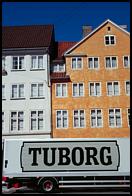

|
Notes from Copenhagen, Denmark |
This is the second of four emails that I sent to various friends when I found Internet access during my trip. You can read it, or skip to one of the other three:
You can also download the original ASCII email
archive, probably more suitable for printing.
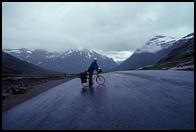 On two separate occasions, while trying to escape from a maze of poorly
sign-posted bike paths in rain-drenched Norwegian suburbs, Rosalba and I
ended up in the parking lots of psychiatric hospitals. On a rational level,
this may be an indication of the effect of long winters and dismal summers,
and of Norway's commitment to bicycle accessibility. On a more personal
level, I took this as a gentle hint to leave that frigid and sodden country
before it became too late.
On two separate occasions, while trying to escape from a maze of poorly
sign-posted bike paths in rain-drenched Norwegian suburbs, Rosalba and I
ended up in the parking lots of psychiatric hospitals. On a rational level,
this may be an indication of the effect of long winters and dismal summers,
and of Norway's commitment to bicycle accessibility. On a more personal
level, I took this as a gentle hint to leave that frigid and sodden country
before it became too late.
Anyway, first the good news: we had two full days of splendid sunshine! Fortunately, the weather coincided with some of the most spectacular fjord terrain, near Andalsnes and Geiranger. In this area, sheer rock walls rise three or four hundred meters out of the water, wispy waterfalls become rainbow-colored mist long before hitting the water's deep green surface, and snowfields sparkle far above among the mountaintops. The sun makes all the difference here: dull and barren during a rainstorm, the fjord becomes magical at sunrise under a blue sky. The cycling was alpine---a typical road into or out of these fjords has an elevation change of 700-1000m with ~10% grades---but in good weather the views easily reward the effort.
Unfortunately, the rest of our time in Norway was pretty wet and cold. Despite their enthusiastic assertions that, "Really, just last month we had two weeks of sunshine," most Norwegians agreed that we were having an authentic experience. In Bergen, on the western coast, it rains 3 days out of 4 throughout the year, and summer is the "wet" season. Next time I'll do better research rather than just looking at a map and picking some out-of-the-way location!
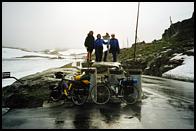 While Rosalba is doing well, my bike and I are showing a few signs of wear.
The list of troubles so far:
While Rosalba is doing well, my bike and I are showing a few signs of wear.
The list of troubles so far:
These adventures, combined with the rest days necessary to recover from my various stomach problems, have shortened my trip so far by about 25% relative to the plan, for a total of about 2400km thus far. Since Rosalba must be in Prague on August 22 to return to the US, we're skipping northern Germany and taking the ferry from Copenghagen straight to Poland. I hear the weather's nice in Poland right now..
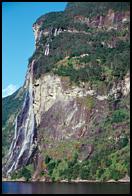
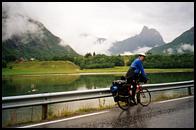 I must admit that my overall impression of Norway is a little dispiritng. I
will remember the low clouds and wind-driven rain, the grand and harshly
beautiful landscape, and the gaily-colored but often poor and slightly
run-down wooden houses clinging for dear life to that little strip of green
between rock and water. In Geiranger I heard stories of children at play
tied to rocks so that they wouldn't plunge into the waters below, and saw
farms that could only be accessed with ladders yet managed to eek out 60kg
of apricots a season from the vertical rocks. Norwegians are incredibly
resilient and proud of their land. The pride is touching, and I can
understand its origins, but it still fills me with wonder. I find it
strange that Italy is so much gentler and easier to live in, and yet that
most Italians are so much less proud of their land. Maybe it takes effort
to build pride, I don't know.
I must admit that my overall impression of Norway is a little dispiritng. I
will remember the low clouds and wind-driven rain, the grand and harshly
beautiful landscape, and the gaily-colored but often poor and slightly
run-down wooden houses clinging for dear life to that little strip of green
between rock and water. In Geiranger I heard stories of children at play
tied to rocks so that they wouldn't plunge into the waters below, and saw
farms that could only be accessed with ladders yet managed to eek out 60kg
of apricots a season from the vertical rocks. Norwegians are incredibly
resilient and proud of their land. The pride is touching, and I can
understand its origins, but it still fills me with wonder. I find it
strange that Italy is so much gentler and easier to live in, and yet that
most Italians are so much less proud of their land. Maybe it takes effort
to build pride, I don't know.
One aspect of Norwegian national enthusiasm that I won't miss is the tourism promotion industry. I love the helpful tourist bureaus and the clean campsites, but I can really do without the constant Disneyland-like marketing of countless indistinguishable fishing villages turned tourist traps. Even on a bike---probably the most independent method of travel, as long as you bring enough spare parts---it's hard to avoid the advertising, and after a few weeks it starts to be annoying.
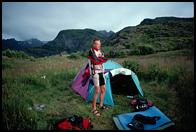 Some of the Norwegians I met were wonderfully friendly and helpful, but on
the whole the national character seemed rather reserved and quiet. What
contact I missed with locals, however, was made up by encounters with other
cyclists on the road, mostly Germans in search of adventure and various
random luddites and idealists escaping civilized society. There was the
German rasta-man with the fearsome tangled beard who had cycled all the way
from Germany to North Cape on a battered old city bike (sort of like an old
English 3-speed) with just a couple of canvas bags strapped onto the pannier
racks. There was the Swiss-Canadian couple on the road for about two years,
from Switzerland to Ukraine, then from Turkey across southern Europe to
Scandinavia. There was the crazy German with panniers that were made of
sheet metal and covered with solar panels to drive the impressive array of
electronics (walkman, computer, you name it) on his handlebars. Not to
mention the Norwegian luddite who thought that modern knowledge (even
electricity!) was evil, and who had been sleeping in his tent and living
more or less off the land for the last year. I mentioned that his bike was
the product of an advanced steel-making and petroleum-refining industry, but
this did not seem to alter his reasoning. Now I understand that I am a
luddite only by MIT standards, if at all. The friendliest (and in many ways
most normal) cyclist I met was Bernd, a German triathlete on a grand cycling
tour of Scandinavia. We cycled together for almost a week, until he ended
his journey in Trondheim and I stopped to wait for Rosalba. His company
helped to keep me sane during long days of rain. Whereas I bought a kitchen
scale to decide what to pack for my trip, this guy had the opposite
philosophy. He is into handicrafts (metalwork, woodwork, etc.), and if he
saw a cool bit of junk by the side of the road that could come in useful for
his tinkering, he'd strap it onto the end of his bike. By the end of the
trip, the bike and gear weighed 59kg! Despite that, he was still quite
fast, even on long hills! Maybe we'll ride coast-to-coast some year...
Some of the Norwegians I met were wonderfully friendly and helpful, but on
the whole the national character seemed rather reserved and quiet. What
contact I missed with locals, however, was made up by encounters with other
cyclists on the road, mostly Germans in search of adventure and various
random luddites and idealists escaping civilized society. There was the
German rasta-man with the fearsome tangled beard who had cycled all the way
from Germany to North Cape on a battered old city bike (sort of like an old
English 3-speed) with just a couple of canvas bags strapped onto the pannier
racks. There was the Swiss-Canadian couple on the road for about two years,
from Switzerland to Ukraine, then from Turkey across southern Europe to
Scandinavia. There was the crazy German with panniers that were made of
sheet metal and covered with solar panels to drive the impressive array of
electronics (walkman, computer, you name it) on his handlebars. Not to
mention the Norwegian luddite who thought that modern knowledge (even
electricity!) was evil, and who had been sleeping in his tent and living
more or less off the land for the last year. I mentioned that his bike was
the product of an advanced steel-making and petroleum-refining industry, but
this did not seem to alter his reasoning. Now I understand that I am a
luddite only by MIT standards, if at all. The friendliest (and in many ways
most normal) cyclist I met was Bernd, a German triathlete on a grand cycling
tour of Scandinavia. We cycled together for almost a week, until he ended
his journey in Trondheim and I stopped to wait for Rosalba. His company
helped to keep me sane during long days of rain. Whereas I bought a kitchen
scale to decide what to pack for my trip, this guy had the opposite
philosophy. He is into handicrafts (metalwork, woodwork, etc.), and if he
saw a cool bit of junk by the side of the road that could come in useful for
his tinkering, he'd strap it onto the end of his bike. By the end of the
trip, the bike and gear weighed 59kg! Despite that, he was still quite
fast, even on long hills! Maybe we'll ride coast-to-coast some year...
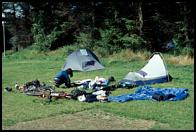 My Danish experience is in many ways better than the Norwegian one. The sun
shines. Sometimes there are tail winds. Supermarkets carry more than one
kind of cheese. Really, unlike Norway, Denmark doesn't feel like a frontier
region, and after enough time cycling up north I really appreciate that.
Gone are the wind-whipped fishermen's huts. In their place you find rows of
elegant red brick houses with luxuriant flower gardens and meticulously
manicured lawns. In many parts of Norway, people's energies seemed focused
on surviving. Snowplows are mounted on 16-ton tanks. In Denmark, people
can afford to spend time picking the weeds that grow in between the bricks
in their driveways. Well-fed cattle wander happily through lush rolling
fields. I haven't even seen a snowplow yet. And Copenhagen is a true
European city, comparable to places like Paris and Rome: it has large
immigrant communities (the first I've seen so far on this trip), good cheap
restaurants, and splendid architecture. Copenhagen is also a bicycle
paradise: major roads have the equivalent of a full lane in each direction
devoted to bicycles, there is a small bike store on average every 5 or 6
blocks, and downtown I would say that bikes outnumber all other vehicles by
about 2-to-1 or more. Bikes are so common that I've even had trouble
finding a bicycle postcard, even though I've searched really hard for one...
My Danish experience is in many ways better than the Norwegian one. The sun
shines. Sometimes there are tail winds. Supermarkets carry more than one
kind of cheese. Really, unlike Norway, Denmark doesn't feel like a frontier
region, and after enough time cycling up north I really appreciate that.
Gone are the wind-whipped fishermen's huts. In their place you find rows of
elegant red brick houses with luxuriant flower gardens and meticulously
manicured lawns. In many parts of Norway, people's energies seemed focused
on surviving. Snowplows are mounted on 16-ton tanks. In Denmark, people
can afford to spend time picking the weeds that grow in between the bricks
in their driveways. Well-fed cattle wander happily through lush rolling
fields. I haven't even seen a snowplow yet. And Copenhagen is a true
European city, comparable to places like Paris and Rome: it has large
immigrant communities (the first I've seen so far on this trip), good cheap
restaurants, and splendid architecture. Copenhagen is also a bicycle
paradise: major roads have the equivalent of a full lane in each direction
devoted to bicycles, there is a small bike store on average every 5 or 6
blocks, and downtown I would say that bikes outnumber all other vehicles by
about 2-to-1 or more. Bikes are so common that I've even had trouble
finding a bicycle postcard, even though I've searched really hard for one...
Go on to Notes from Ceske Budejovice, Czech Republic.
| Top |